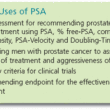Obesity and prostate cancer screening incidence and mortality
The study investigated how body mass index (BMI) relates to prostate cancer screening results, incidence, and mortality among men participating in the Prostate, Lung, Colorectal, and Ovarian (PLCO) Cancer Screening Trial. This trial included 36,756 men who were regularly screened for prostate cancer using prostate-specific antigen (PSA) tests and digital rectal exams between 1993 and 2001.

The findings revealed that men with higher BMI were less likely to have positive screening results from the PSA test or digital rectal exam. Instead, they were more likely to have inconclusive or inadequate screening outcomes. Despite this, higher BMI was linked to a lower risk of developing prostate cancer overall. Specifically, for every 5 kg/m2 increase in BMI, the risk of prostate cancer incidence decreased by 6%. This trend was observed for both early-stage and advanced-stage prostate cancers. Interestingly, despite the lower incidence of prostate cancer among men with higher BMI, they faced a higher risk of dying from prostate cancer. The study found a 21% increased risk of prostate cancer mortality for every 5 kg/m2 increase in BMI.
These results suggest that while obesity might reduce the likelihood of detecting prostate cancer through screening, it
paradoxically increases the risk of mortality once prostate cancer develops. This indicates that obesity’s impact on prostate cancer mortality is not solely due to delayed diagnosis. Potential biological factors linking obesity to more aggressive forms of prostate cancer include changes in hormone levels, insulin sensitivity, and chronic inflammation.
Understanding these associations is crucial, especially as obesity rates rise globally. This underscores the need for further research to clarify these relationships and identify opportunities for intervention.
J Natl Cancer Inst. 2023 Dec; 115(12): 1506–1514. Published online 2023 Jun 29. doi: 10.1093/jnci/djad113





















